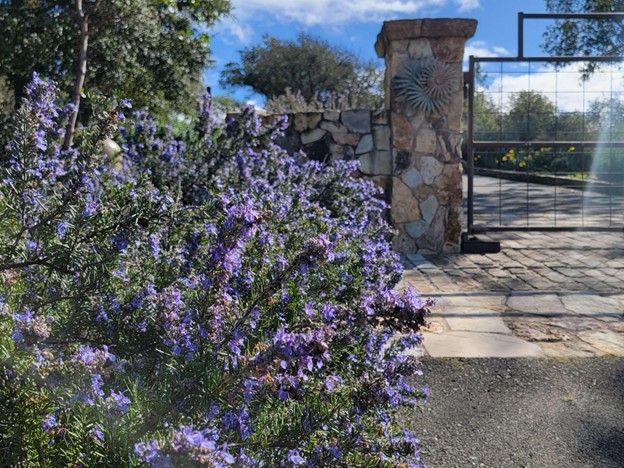
Importance of Native Plants in Your Landscape
Native plants play a vital role in the ecosystems of any specific region and should be a central component of decisions made by landscape designers in Sonoma County. These plants have evolved over thousands of years to thrive in the specific climate and conditions of the area, making them well-suited for sustainable, low maintenance, water conserving landscapes while also supporting the larger ecosystem.
Supporting Wildlife
One of the most important benefits of native plants is their ability to support local wildlife. Many species of birds, butterflies, and other pollinators rely on specific native plants for food and habitat. Epilobium canum ‘California Fuchsia’ and Salvia spathacea are favorites of hummingbirds, while Eriogonum fasciculatum ‘California Buckwheat’ and Asclepias fasciuclaris ‘Narrow Leaf Milkweed’ are favorites of butterflies including the prized and endangered Monarch.
Flowering perennials aren’t the only plants worth considering as many shrubs are essential for creating habitat. Rhamnus californica ‘Coffeberry’ is a favorite hiding place for quail and other small birds, as are native grasses such as Elymus condensatus ‘CA Rye Grass’. Berries and seed heads of these shrubs and grasses are also a food source for local birds which is not only great for them, but adds to the beauty of your landscape when they visit your plants for a snack. By incorporating native plants into your landscape installation in Sonoma County, you can help support these important species and contribute to the overall health of the local ecosystem.
Deep Roots Mean Drought Resilience
Sonoma county native plants also tend to have deep roots that help to reduce soil erosion and retain moisture in the soil. This is critical in our climate where dry summers and wet winters can make it difficult to maintain a healthy landscape without copious amounts of summer irrigation. The deep roots of native plants help anchor the soil which in turn helps the soil structure maintain water and remain available to plants during summer months. When the top layers of the soil profile are exceptionally dry during peak summer months, these roots are able to find sources of moisture that are unattainable to exotic plants with shallow root systems. While the exotic plants quickly wilt without excessive irrigation, these native plants remain calm and thrive when one would least expect it!
These roots also help retain steep slopes which are hard to amend for planting and to irrigate as water wants to quickly run down the slope. When dealing with challenging slopes, contact landscape irrigation specialists in Sonoma County to help design an irrigation system. Since native plants thrive in the existing soil conditions and require very little water once established, they are ideal selections for these challenging locations. Ceanothus ‘Yankee Point’’ and Salvia sonomensis ‘Creeping Sage’ are a fantastic plants for these kinds of slopes as they grow rapidly and horizontally across the ground which breaks up rainfall which erodes the soil and both thrive in dry conditions so they are perfectly happy with the limited ability to irrigate them!
Less Maintenance and More Sustainability
In addition to the ecological benefits, native plants are low-maintenance and require less water and fertilizer than non-native plants. This is because they are accustomed to the seasonal temperature changes of our local climate and thrive in native soils without the need for importing soil which results in increased carbon emissions through trucking and excessive tilling which releases carbon stored in the native soil. This makes native plants a great choice for local gardeners with a focus on sustainable practices while also creating a beautiful landscape free from the expense and added effort of growing exotic species. Regardless, hiring qualified landscapers in Sonoma County will ensure your native landscape gets the proper care.
Picking the Appropriate Plant for Each Location
Not all native plants are suited for every Sonoma County landscape so we still must consider the specific microclimates within your property to make the right selections. For example an open sunny area is perfect for a variety of Arctostaphylos ‘Manzanita’ species commonly seen in the rolling hills, while a shady slope under trees is well suited for ferns such as Woodwardia fimbriata ‘Giant Chain Fern’ or Vaccinum ovatum ‘Evergreen Huckleberry’ as seen in the forests along the coast. Speaking with a landscape design consultant in Sonoma County will ensure you place plants in locations which will allow them to thrive.
Importance of Responsible Pest Control
When maintaining a native landscape it’s important to avoid the use of pesticides and herbicides whenever possible as these chemicals can harm the local wildlife and larger ecosystem that these sustainable practices are aimed to support. We want to be sure we aren’t poisoning the very animals and insects we are attracting to share our gardens! Instead using integrated pest management (IPM), companion plantings (to attract desirable predator insects or repel unwanted animals like gophers or deer), hand weeding, and organic fertilizers.
Inspired Landscapes LLC provides landscape maintenance services in Sonoma County which is focused on sustainable principles so that you can skip all the research and guesswork of which products are safe or not. Our extensive experience in ecologically focused landscaping practices has shown us which products are safe and effective in reducing the amount, or completely eliminating the need for chemical sprays or soil drenches to contain pests and disease.
Incorporating native plants should be a central focus of your landscape design in Sonoma County will provide tremendous benefit to the local ecosystem. Doing so, especially in tandem with low impact sustainable practices, will support local wildlife, reduce soil erosion, reduce carbon emissions, require less maintenance, and consume minimal irrigation water if any at all! With their specific adaptations to the local environment they will add beauty to your landscape while also helping you become an active steward of the land!





